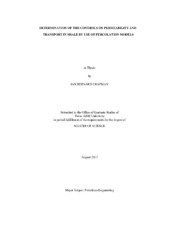| dc.description.abstract | A proper understanding of reservoir connectivity is essential to understanding the relationship between the porosity and the permeability within it. Additionally, the construction of an accurate reservoir model cannot be accomplished without this information. While a great deal is known about the connectivity in conventional sandstone systems, little is understood about the connectivity and its resultant properties within shale systems. Percolation theory is a method to describe the global properties of the shale system by understanding the nanometer scale interaction of pore space.
In this study we use both analytical and empirical techniques to further understand shale pore scale interactions as well as global phenomena of the shale system. Construction of pore scale connectivity simulations on lattice and in the continuum allow for understanding relationships between pore topology, system porosity and system permeability. Additionally, questions regarding the role of Total Organic Carbon as well as natural fractures in contributing to shale permeability will be discussed. Analytical techniques are used to validate simulation results regarding the onset of percolation and related pore topology. Finally, time of flight simulation is used to further understand pressure transient behavior in the resulting topological models.
High aspect ratio pores are shown to be the driver of shale permeability as opposed to the low aspect ratio pore space associated with organic matrix. Additionally, systems below the percolation threshold are likely able to produce because the wellbore will often encounter near infinite clusters. Finally, a characteristic volume growth profile is shown for a multi-porosity system whereby each level of porosity displays a corresponding stair step of volume growth in time. | en |


